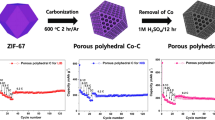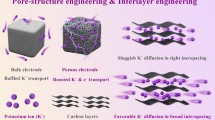Abstract
K3V2(PO4)3 (KVP) can be employed as a potential cathode material for potassium-ion batteries owing to its high theoretical capacity (106 mA h g−1). However, the inherently poor electronic conductivity of KVP severely restricts its electrochemical performance. In this study, a citric-acid-assisted sol–gel method was used to synthesise a three-dimensional porous-framework-supported K3V2(PO4)3/C composite material. A convenient three-dimensional channel and a conductive carbon skeleton were formed in a porous structure between K3V2(PO4)3 particle covered by in situ carbon layers. Among the fabricated composites, K3V2(PO4)3/C prepared at 800 °C exhibited an optimal discharge specific capacity (76 mA h g−1 at 20 mA g−1), superior rate performance (discharge capacity of 37 mA h g−1 at 400 mA/g), and cycling stability (discharge capacity of 43 mA h g−1 after 100 cycles at 200 mA g−1). The improved performance was attributed to the three-dimensional porous conductive structure. This structure can improve the electrical conductivity, increase the electrode/electrolyte contact surface area, accelerate the electrode kinetics, and enhance the structure stability. The strategy involving the synthesis of three-dimensional porous structures may enable the development of high-performance potassium-ion batteries.













Similar content being viewed by others
References
Yang Z, Zhang J, Kintner-Meyer MCW, Lu X, Choi D, Lemmon JP, Liu J (2011) Electrochemical energy storage for green grid. Chem Rev 111:3577–3613. https://doi.org/10.1021/cr100290v
Larcher D, Tarascon JM (2015) Towards greener and more sustainable batteries for electrical energy storage. Nat Chem 7:19–29. https://doi.org/10.1038/nchem.2085
Li M, Lu J, Chen ZW, Amine K (2018) 30 years of lithium-ion batteries. Adv Mater 30:1800561. https://doi.org/10.1002/adma.201800561
Kubota K, Dahbi M, Hosaka T, Kumakura S, Komaba S (2018) Towards K-ion and Na-ion batteries as “beyond Li-ion.” Chem Rec 18(4):459–479. https://doi.org/10.1002/tcr.201700057
Hosaka T, Kubota K, Hameed AS, Komaba S (2020) Research development on K-ion batteries. Chem Rev 120:6358–6466. https://doi.org/10.1021/acs.chemrev.9b00463
Wang MY, Zhang HM, Cui J, Yao SS, Shen X, Park TJ, Kim JK (2021) Recent advances in emerging nonaqueous K-ion batteries: from mechanistic insights to practical applications. Energy Storage Mater 39:305–346. https://doi.org/10.1016/j.ensm.2021.04.034
Min X, Xiao J, Fang MH, Wang W, Zhao YJ, Liu YG, Abdelkader AM, Xi K, Kumar RV, Huang ZH (2021) Potassium-ion batteries: outlook on present and future technologies. Energy Environ Sci 14:2186–2243. https://doi.org/10.1039/d0ee02917c
Komaba S, Hasegawa T, Dahbi M, Kubota K (2015) Potassium intercalation into graphite to realize high-voltage/high-power potassium-ion batteries and potassium-ion capacitors. Electrochem Commun 60:172–175. https://doi.org/10.1016/j.elecom.2015.09.002
Pramudita JC, Sehrawat D, Goonetilleke D, Sharma S (2017) An initial review of the status of electrode materials for potassium-ion batteries. Adv Energy Mater 7:1602911. https://doi.org/10.1002/aenm.201602911
Sha M, Liu L, Zhao HP, Lei L (2020) Review on recent advances of cathode materials for potassium-ion batteries. Energy Environ Mater 3:56–66. https://doi.org/10.1002/eem2.12060
Wu ZR, Zou J, Chen SL, Niu XB, Liu J, Wang LP (2021) Potassium-ion battery cathodes: Past, present, and prospects. J Power Sources 484:229307. https://doi.org/10.1016/j.jpowsour.2020.229307
Hosaka T, Shimamura T, Kubota K, Komaba S (2019) Polyanionic compounds for potassium-ion batteries. Chem Rec 19:735–745. https://doi.org/10.1002/tcr.201800143
Wang JY, Ouyang B, Kim H, Tian YS, Ceder G, Kim H (2021) Computational and experimental search for potential polyanionic K-ion cathode materials. J Mater Chem A 9:18564–21857. https://doi.org/10.1039/d1ta05300k
Qu QT, Li L, Tian S, Guo WL, Wu YP, Holze R (2010) A cheap asymmetric supercapacitor with high energy at high power: activated carbon//K0.27MnO2·0.6H2O[J]. J Power Sources 195:2789–2794. https://doi.org/10.1016/j.jpowsour.2009.10.108
Zhang L, Zhang B, Wang C, Dou Y, Zhang Q, Liu Y, Gao H, Al-Mamun M, Pang WK, Guo Z, Dou SX, Liu HK (2019) Constructing the best symmetric full K-ion battery with the NASICON-type K3V2(PO4)3. Nano Energy 60:432–439. https://doi.org/10.1016/j.nanoen.2019.03.085
Han J, Li GN, Liu F, Wang M, Zhang Y, Hu L, Dai C, Xu M (2017) Investigation of K3V2(PO4)3/C nanocomposites as high-potential cathode materials for potassium-ion batteries. Chem Commun 53:1805–1808. https://doi.org/10.1039/C6CC10065A
Zheng S, Cheng S, Xiao S, Hu L, Chen Z, Huang B, Liu Q, Yang J, Chen Q (2020) Partial replacement of K by Rb to improve electrochemical performance of K3V2(PO4)3 cathode material for potassium-ion batteries. J Alloys Compd 815:152379. https://doi.org/10.1016/j.jallcom.2019.152379
Zhang X, Kuang X, Zhu H, Xiao N, Zhang Q, Rui X, Yu Y, Huang S (2020) Hybrid cathodes composed of K3V2(PO4)3 and carbon materials with boosted charge transfer for K-ion batteries [J]. Surface 3(1):1–10. https://doi.org/10.3390/surfaces3010001
Jenkins T, Alarco JA, Mackinnon I (2021) Synthesis and characterization of a novel hydrated layered vanadium (III) phosphate phase K3V3(PO4)4·H2O: a functional cathode material for potassium-ion batterieS. ACS Omega 6(3):1917–1929. https://doi.org/10.1021/acsomega.0c04675
Liu Z, Yuan X, Zhang S, Wang J, Huang Q, Yu N, Zhu Y, Fu L, Wang F, Chen Y, Wu Y (2019) Three-dimensional ordered porous electrode materials for electrochemical energy storage. NPG Asia Mater 11:12. https://doi.org/10.1038/s41427-019-0112-3
Delhez R, de Keijser ThR, Mittemeijer EJ, Langford J (1988) Size and strain parameters from peak profiles: sense and nonsense. Aust J Phys 41(2):213–228. https://doi.org/10.1071/PH880213
Leineweber A (2011) Understanding anisotropic microstrain broadening in Rietveld refinement. Zeitschrift fur Kristallographie 226(12):905–923. https://doi.org/10.1524/zkri.2011.1413
Guo S, Bai Y, Geng Z, Wu F, Wu C (2019) Facile synthesis of Li3V2(PO4)3/C cathode material for lithium-ion battery via freeze-drying. J Energy Chem 32:159–165. https://doi.org/10.1016/j.jechem.2018.07.011
Rui XH, Jin Y, Feng XY, Zhang LC, Chen CH (2011) A comparative study on the low-temperature performance of LiFePO4/C and Li3V2(PO4)3/C cathodes for lithium-ion batteries. J Power Sources 196(4):2109–2114. https://doi.org/10.1016/j.jpowsour.2010.10.063
Wei Q, An Q, Chen D, Mai L, Chen S, Zhao Y, Hercule KM, Xu L, Minhas-Khan A, Zhang Q (2014) One-pot synthesized bicontinuous hierarchical Li3V2(PO4)3/C mesoporous nanowires for high-rate and ultralong-life lithium-ion batteries. Nano Lett 14(2):1042–1048. https://doi.org/10.1021/nl404709b
Vu A, Qian YQ, Stein A (2012) Porous electrode materials for lithium-ion batteries – how to prepare them and what makes them special. Adv Energy Mater 2(9):1056–1085. https://doi.org/10.1002/aenm.201200320
Wu H, Du N, Wang J, Zang H, Yang D (2014) Three-dimensionally porous Fe3O4 as high-performance anode materials for lithium–ion batteries. J Power Sources 246:198–203. https://doi.org/10.1016/j.jpowsour.2013.07.063
Zhang Z, Zhao X, Li J (2016) SnSex flowerlike composites as anode materials for sodium ion batteries. Mater Lett 162:169–172. https://doi.org/10.1016/j.matlet.2015.09.126
Wang X, Niu C, Meng J, Hu P, Xu X, Wei X, Zhou L, Zhao LW, Yan M, Mai L (2015) Novel K3V2(PO4)3/C bundled nanowires as superior sodium-ion battery electrode with ultrahigh cycling stability. Adv Energy Mater 5(17):1500716. https://doi.org/10.1002/aenm.201500716
Wang E, Chen M, Liu X, Liu Y, Guo H, Wu Z, Xiang W, Zhong B, Guo X, Chou S, Dou SX (2019) Organic cross-linker enabling a 3D porous skeleton-supported Na3V2(PO4)3/carbon composite for high power sodium-ion battery cathode. Small Methods 3(4):1800169. https://doi.org/10.1002/smtd.201800169
Zhao L, Zhao H, Wang J, Zhang Y, Li Z, Du Z, Świerczek K, Hou Y (2021) Micro/nano Na3V2(PO4)3/N-doped carbon composites with a hierarchical porous structure for high-rate pouch-type sodium-ion full-cell performance. ACS Appl Mater Interfaces 13(7):8445–8454. https://doi.org/10.1021/acsami.0c21861
Liu J, Tang K, Song K, van Aken PA, Yu Y, Maier J (2014) Electrospun Na3V2(PO4)3/C nanofibers as stable cathode materials for sodium-ion batteries. Nanoscale 6:5081–5086. https://doi.org/10.1039/c3nr05329f
Sebastián D, Suelves I, Moliner R, Lázaro MJ (2010) The effect of the functionalization of carbon nanofibers on their electronic conductivity. Carbon 48(15):4421–4431. https://doi.org/10.1016/j.carbon.2010.07.059
Fang Y, Xiao L, Ai X, Cao Y, Yang H (2015) Hierarchical carbon framework wrapped Na3V2(PO4)3 as a superior high-rate and extended lifespan cathode for sodium-ion batteries. Adv Mater 27(39):5895–5900. https://doi.org/10.1002/adma.201502018
Jiang Y, Yang Z, Li W, Zeng L, Pan F, Wang M, Wei X, Hu G, Gu L, Yu Y (2015) Nanoconfined carbon-coated Na3V2(PO4)3 particles in mesoporous carbon enabling ultralong cycle life for sodium-ion batteries. Adv Energy Mater 5(10):1402104. https://doi.org/10.1002/aenm.201402104
Sing KSW, Everett DH, Haul RAW, Moscou L, Pierotti RA, Rouquerol J, Siemieniewska T (1985) Reporting physisorption data for gas/solid systems with special reference to the determination of surface area and porosity. Pure Appl Chem 57(4):603–619. https://doi.org/10.1351/pac198557040603
Ling R, Cai S, Xie D, Li X, Wang M, Lin Y, Jiang S, Shen K, Xiong K, Sun X (2018) Three-dimensional hierarchical porous Na3V2(PO4)3/C structure with high rate capability and cycling stability for sodium-ion batteries. Chem Eng J 353:264–272. https://doi.org/10.1016/j.cej.2018.07.118
Jiang Y, Zhou X, Li D, Cheng X, Liu F, Yu Y (2018) Highly reversible Na storage in Na3V2(PO4)3 by optimizing nanostructure and rational surface engineering. Adv Energy Mater 8(16):1800068. https://doi.org/10.1002/aenm.201800068
Gao H, Wang Y (2007) Preparation of (Gd, Y)AlO3:Eu3+ by citric-gel method and their photoluminescence under VUV excitation. J Lumin 122–123:997–999. https://doi.org/10.1016/j.jlumin.2006.01.349
Zhou RS, Song JF, Yang QF, Xu XY, Xu JQ, Wang TG (2008) Syntheses, structures and magnetic properties of a series of 2D and 3D lanthanide complexes constructed by citric ligand. J Mol Struct 877(1–3):115–122. https://doi.org/10.1016/j.molstruc.2007.07.027
Khanmohammadi M, Garmarudi AB (2012) Infrared spectroscopy in biodiagnostics: a green analytical approach. In: de la Guardia M, Garrigues S (Eds.) Handbook of green analytical chemistry. Wiley, pp 449–474. https://doi.org/10.1002/9781119940722.ch21
Berto S, Daniele PG, Prenesti E, Laurenti E (2010) Interaction of oxovanadium (IV) with tricarboxylic ligands in aqueous solution: a thermodynamic and spectroscopic study. Inorg Chim Acta 363(13):3469–3476. https://doi.org/10.1016/j.ica.2010.06.047
Burojevic S, Shweky I, Bino A, Summers DA, Thompson RC (1996) Synthesis, structure and magnetic properties of an asymmetric dinuclear oxocitratovanadate(IV) complex. Inorg Chim Acta 251(1–2):75–79. https://doi.org/10.1016/S0020-1693(96)05254-1
Hennings D, Mayr W (1978) Thermal decomposition of (BaTi) citrates into barium titanate. J Solid State Chem 26(4):329–338. https://doi.org/10.1016/0022-4596(78)90167-6
Liu H, Li J, Zhang Z, Gong Z, Yang Y (2003) The effects of sintering temperature and time on the structure and electrochemical performance of LiNi0.8Co0.2O2 cathode materials derived from sol–gel method. J Solid State Electrochem 7:456–462. https://doi.org/10.1007/s10008-002-0342-z
Chen M, Zhang YG, Xing LD, Liao YH, Qiu YC, Yang SH, Li WS (2017) Morphology-conserved transformations of metal-based precursors to hierarchically porous micro-/nanostructures for electrochemical energy conversion and storage [J]. Adv Mater 29:1607015. https://doi.org/10.1002/adma.201607015
Zhang X, Liu G, Zhou K, Jiao T, Zou Y, Wu Q, Chen X, Yang Y, Zheng J (2021) Enhancing cycle life of nickel-rich LiNi0.9Co0.05Mn0.05O2 via a highly fluorinated electrolyte additive-pentafluoropyridine. J Energy Mater 1:100005–100019. https://doi.org/10.20517/energymater.2021.07
Kretschmer K, Sun B, Zhang J, Xie X, Liu H, Wang G (2017) 3D interconnected carbon fiber network-enabled ultralong life Na3V2(PO4)3@Carbon paper cathode for sodium-ion batteries. Small 13(9):1603318. https://doi.org/10.1002/smll.201603318
Huang X, Yi X, Yang Q, Guo Z, Ren Y, Zeng X (2020) Outstanding electrochemical performance of N/S co-doped carbon/Na3V2(PO4)3 hybrid as the cathode of a sodium-ion battery. Ceram Int 46(18):28084–28090. https://doi.org/10.1016/j.ceramint.2020.07.303
Cong X, Wang T, Shen J, Chen P, Yao H, Wang Z (2020) Na3V2(PO4)3/porous carbon skeleton embellished with ZIF-67 for sodium-ion storage. Inorg Chem 59(13):9252–9260. https://doi.org/10.1021/acs.inorgchem.0c01129
Chen Y, Cheng J, Wang Y, Wang C, He Z, Li D, Guo L (2020) Insights into the elevated electrochemical performance and kinetic characteristics of magnesium-substituted Na3V2−xMgx(PO4)3/C with superior rate capability and long lifespan. J Mater Sci 55:13141–13156. https://doi.org/10.1007/s10853-020-04962-3
Cheng J, Chen Y, Wang Y, Wang C, He Z, Li D, Guo L (2020) Insights into the enhanced sodium storage property and kinetics based on the Zr/Si codoped Na3V2(PO4)3/C cathode with superior rate capability and long lifespan. J Power Sources 474:228632. https://doi.org/10.1016/j.jpowsour.2020.228632
Chen Y, Cheng J, Wang C, He Z, Wang Y, Li D, Guo L (2021) Simultaneous modified Na2.9V1.9Zr0.1(PO4)3/C@rGO as a superior high rate and ultralong lifespan cathode for symmetric sodium ion batteries. Chem Eng J 413:127451. https://doi.org/10.1016/j.cej.2020.127451
Zhang C, Guo D, Qin J, Mao B, Cao M (2017) Rational construction of Na3V2(PO4)3 nanoparticles encapsulated in 3D honeycomb carbon network as a cathode for sodium-ion batteries. Mater Lett 195:205–208. https://doi.org/10.1016/j.matlet.2017.02.121
Funding
The authors received financial support from the National Natural Science Foundation of China (51864005 and 51564002) and the Natural Science Foundation of Guangxi, China (2018GXNSFDA281014).
Author information
Authors and Affiliations
Corresponding author
Additional information
This manuscript has not been published or presented elsewhere in part or in entirety and is not under consideration by another journal. We have read and understood your journal’s policies, and we believe that neither the manuscript nor the study violates any of these.
Publisher’s note
Springer Nature remains neutral with regard to jurisdictional claims in published maps and institutional affiliations.
Rights and permissions
About this article
Cite this article
Kuai, HX., Lu, JF., Lv, XY. et al. High-performance, three-dimensional and porous K3V2(PO4)3/C cathode material for potassium-ion batteries. Ionics 28, 3817–3831 (2022). https://doi.org/10.1007/s11581-022-04612-5
Received:
Revised:
Accepted:
Published:
Issue Date:
DOI: https://doi.org/10.1007/s11581-022-04612-5




